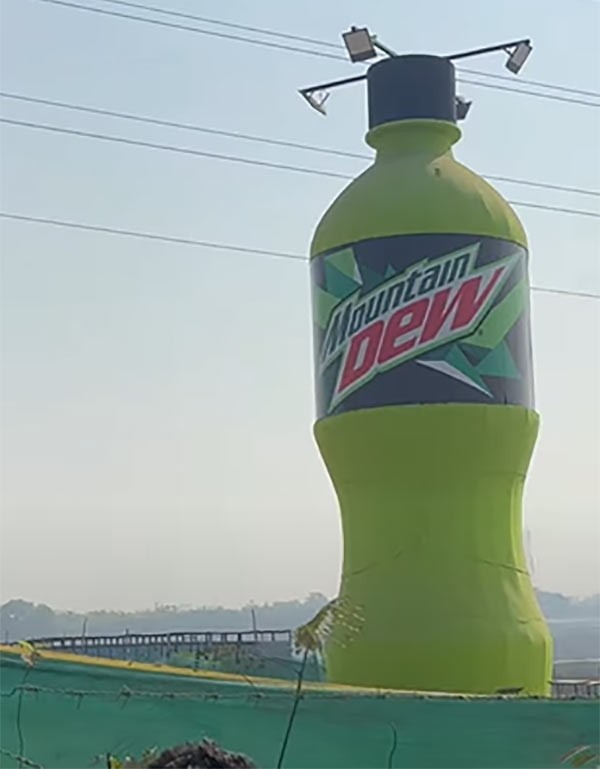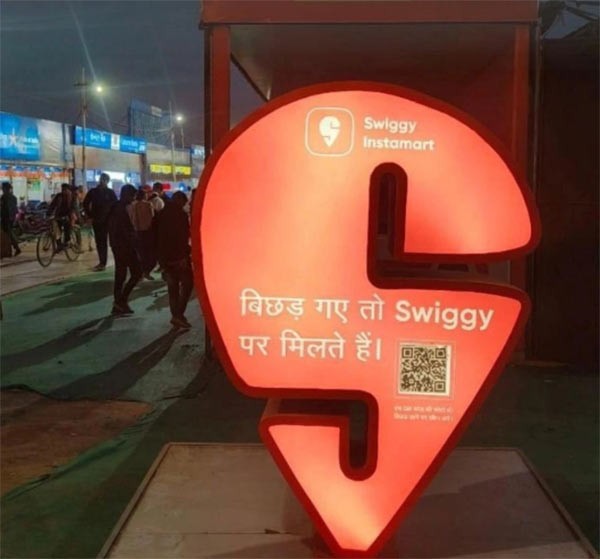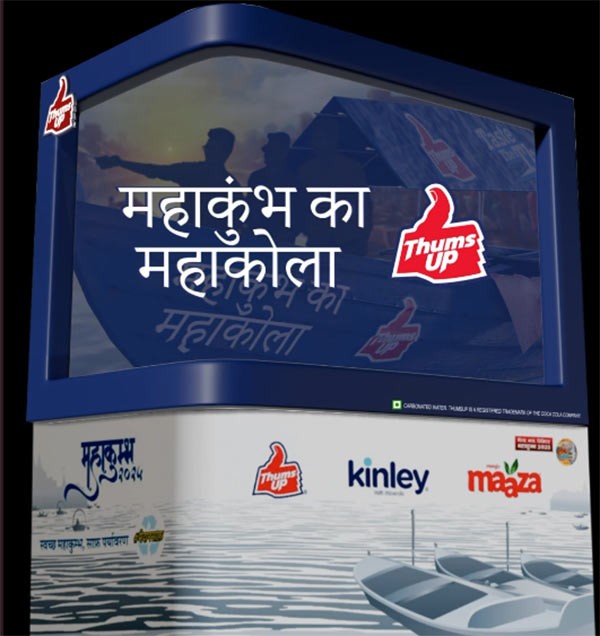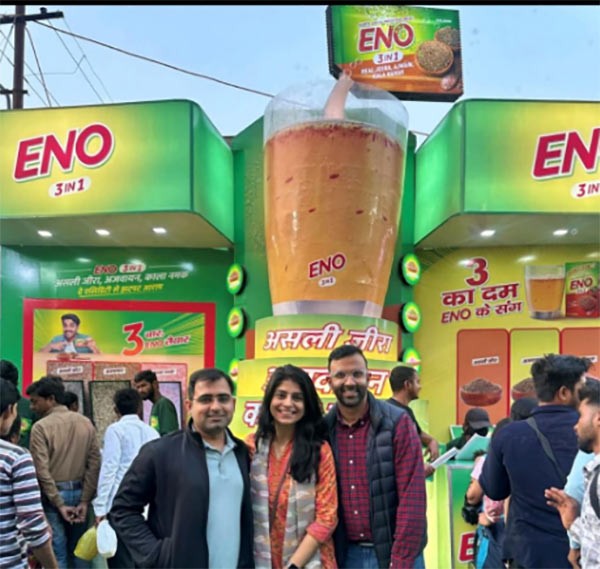With massive traffic jams stretching up to 300 kms and wait time going up to more than 11 hours, Mahakumbh 2025 is witnessing an unprecedented turnout of people. The sheer volume of devotees attending the event has made it one of the world's biggest gatherings.
Adani Group Digital Media General Manager, Chandan Sharma, reveals that there is no limit to brand spending at Mahakumbh, as it is a once-in-a-144-year opportunity for them to reach 400 million people at once. "A brand can spend anywhere between Rs 5 and Rs 10 lakh to crores over 45 days, depending on factors such as scale, duration and approach,” he said.
According to him, brands are expected to spend around Rs 4,000 crore during this period on activation and marketing.
Billboards or Stalls?
Laqshya Media COO, Amarjeet Hudda, emphasises that a combination of billboards and stalls is the most effective approach for brand activation. Billboards offer large-scale visibility at high-traffic locations such as highways and transit hubs, creating mass awareness—exemplified by the AMFI campaign near Varanasi Airport and other key landmarks. Stalls, on the other hand, facilitate direct consumer engagement, providing personalized experiences that foster trust. Together, they ensure top-of-mind recall by combining constant exposure with meaningful interactions.
Hudda also highlights several innovative strategies that help brands integrate seamlessly into the event, driving both immediate engagement and long-term recall. Branded trains, such as AMFI’s Ganga Gomti Express, function as moving billboards, offering multi-region exposure. Augmented Reality (AR) activations create immersive experiences that captivate attendees, while mobile vans equipped with audiovisual setups take brand messaging directly to the crowd. Culturally themed messaging, like Santoor’s “Sangam” campaign, enhances brand resonance by aligning with the event’s ethos. QR codes on billboards and stalls enable instant digital interactions, while merchandise giveaways ensure lasting recall as attendees take branded items home with them.
Chandan also mentioned that stalls and billboards both can be effective for brand activation. But he also suggests several other strategies that can work well in such gatherings, including phone charging booths with branding, Wi-Fi zones, Maha-prasad distribution, dress-changing booths for women, sanitation and hygiene drives.
A single billboard at the event’s entrance is enough to create brand awareness, while more elaborate setups come with a hefty price tag.
For instance, PepsiCo installed a 30-foot-tall, illuminated Mountain Dew bottle to help pilgrims navigate and find their way, especially at night. Larger gatherings tend to have more challenges. Focusing on solving a problem can resonate with people and get mileage for the brands instead of just going for marketing or activations.

Industry expert estimated that brands have already collectively invested between Rs 1,800 crore to Rs 2,000 crore in advertising campaigns, marketing activations, and digital amplification to capitalize on this unprecedented reach. This surge in demand has caused ad inventories in Prayagraj to be priced 8-10 times higher than usual, making media planning a challenge for advertisers.
For instance, hoardings-flex, with an inventory of 300 units, are priced at Rs 10 lakh each for the entire duration of the Mela. Similarly, a gantry or box gate, limited to just 50 units, commands a staggering Rs 25 lakh per unit. Even smaller-scale advertising options, such as electric poles, are priced at Rs 30,000 each, as per the rate list from Shreyas Media.
In response, brands are stepping in to ensure that whoever enters the sangam don’t miss their brand and some are also making sure that pilgrims do not get lost in the grand spectacle, making the saying "Kumbh ke bichade" a thing of the past in this digital-first era.
Swiggy Instamart has launched the S-PIN Landmark campaign, designed to help devotees navigate their way back with ease. By scanning a QR code on the installation, pilgrims can seamlessly find their return route.

PhonePe has introduced insurance plans tailored for Maha Kumbh attendees, covering train, bus, and flight travelers.
Coca-Cola India and South West Asia, Vice President Marketing Greishma Singh, added, “We are creating an end-to-end experience for visitors at Kumbh with stepped up availability, visibility and innovative marketing touch points for our entire portfolio of beverages. Influencers form an integral part of the way we tell our stories. As they share their experiences with their own unique approach, they provide a lens for their fans to enjoy and be a part of this magical experience.”
“We are committed to creating social impact through multiple initiatives at the event, that showcase the potential of repurposed packaging and raise awareness about recycling to inspire collective action,” she mentioned.

A senior executive from a top FMCG brand told exchange4media, that most ad inventories at Kumbh are priced significantly higher than the usual rates in Prayagraj, leaving brands cautious about their ad spends.
Brands can also ditch this tradition and take inspiration from Lifeboy’s innovative campaign during the 2013 Kumbh Mela. Hindustan Unilever, in collaboration with Ogilvy, introduced a cost-effective yet impactful strategy by stamping a message, Aapne haath dhoya kya? (Have you washed your hands?), on every roti served at the community kitchens. This not only spread awareness about hygiene but also subtly promoted Lifebuoy, proving that effective marketing doesn’t always require massive spending.
Haleon, a premium brand, has installed a digital stall for its product Eno at the Mahakumbh. Sahil Sachdeva, Senior Manager of Digital Marketing at Haleon, stated, "We are on an access mission, providing easy health access to all. This includes free sampling and dental checkups at the Mahakumbh."

Despite the significant investments, brands remain tight-lipped about their exact marketing budgets for the Mahakumbh.
Many brands are engaging in innovative campaigns that strike an emotional chord with consumers.
Nestlé India Director of Foods Rupali Rattan highlighted their ‘2 Minutes Apno Ke Liye’ campaign, which sets up Maggi Corners as resting pods for attendees, fostering moments of togetherness. "Through this campaign, Maggi is creating spaces where people can connect, share stories, and make meaningful memories," she said.
Additionally, Nestlé’s campaign includes honouring the community of waste management professionals (safai karamcharis) who work tirelessly to keep the Kumbh Mela clean. Maggi will provide them with meals and blankets to help them stay warm during the winter.
Nestlé’s Maggi isn’t the only brand making an impact. Many others are running campaigns aimed at delivering positive messages or offering free product samples.
While traditional advertising remains expensive, social media and influencer marketing have emerged as cost-effective alternatives for brands to engage with audiences.
According to a report by Qoruz, Maha Kumbh 2025 has already generated over 11 million social media posts across platforms. Instagram alone has seen 8.6 million posts, while X has recorded 1.7 million, and YouTube has witnessed 637,000 posts related to the event.
Influencers are playing a crucial role in amplifying Maha Kumbh’s digital presence, with nearly 40,000 influencers actively engaging in discussions about the event.
Paid collaborations are also fuelling the buzz, with 3,225 sponsored posts on Instagram alone. The engagement rate for Maha Kumbh-related content stands at an impressive 5.8%, reflecting strong audience interaction.
According to industry experts, Mahakumbh 2025 has become a key event for influencers across various categories, including travel, religion, micro, macro, nano, and celebrity influencers.
Influencers with around 100,000 followers are charging Rs 15,000 per post, while those with a million followers command fees between Rs 1 lakh and Rs 1.5 lakh for Maha Kumbh-related content. Due to the limited number of high-following influencers covering the event, these rates can climb even higher, ranging from Rs 2.5 lakh to Rs 4 lakh per post.
Vaibhav Gupta, Co-founder and CFO of KlugKlug, highlighted that over 3,275 influencers are actively creating content around Maha Kumbh 2025. Their content spans reels, stories, and posts featuring hashtags like #Mahakumbh2025 and #Prayagraj.
Among these, travel and religious influencers are the most active, given the event’s spiritual and cultural significance. "Micro, macro, and nano influencers are all participating, with brands leveraging their reach to connect with diverse audiences. For instance, ITC is collaborating with influencers popular in Uttar Pradesh, Bihar, and Jharkhand to create culturally relevant content," Gupta said.
Amazon has partnered with regional and national influencers to showcase its box beds for devotees at Kumbh, while ITC is also working with regional Instagram influencers for its Bingo snacks campaign.
The influencer activity has generated massive traction, amassing 547.91 million views across posts, along with 380.52K comments and 9.07 million shares. Engagement rates vary by influencer tier, with nano influencers leading at an impressive 202%, followed by micro-influencers at 10.78% and macro-influencers at 3.74%.
This data highlights the effectiveness of smaller creators in driving audience interaction. To monitor digital conversations and track audience sentiment, Qoruz analyzed key trending keywords such as MahaKumbh, KumbhMela, HolyDip, Sangam, KumbhFestival, and MahaKumbh2025. This analysis showcases how brands are strategically leveraging influencer collaborations and digital amplification to establish a strong presence at the grand event.

.jpg)






.jpg)